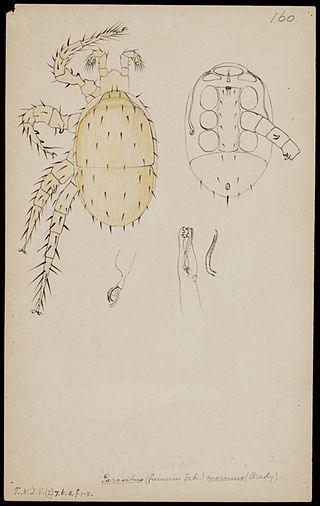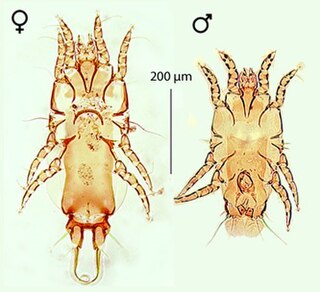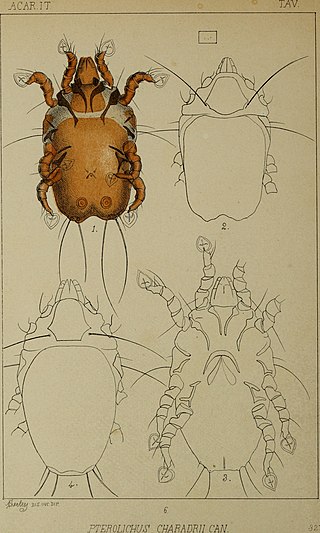
The Acaridae are a family of mites in order Sarcoptiformes.
The Analgoidea are a superfamily of the Acarina (mite) order Sarcoptiformes. They contain many feather mites, being ectoparasites of birds and occasionally mammals.

The Proctophyllodidae are a family of the Acarina (mite) order Astigmata. They contain many feather mites. The Alloptidae and Trouessartiidae were in earlier times included here as subfamilies.

Dermanyssus is a genus of mites in the family Dermanyssidae. The etymology of the word Dermanyssus is from the Greek: derma, meaning skin, and nyssein, meaning bite.

Dermanyssidae is a family of mites in the order Mesostigmata.

Halolaelapidae is a family of mites in the order Mesostigmata.

Proctophyllodes is a genus of feather mites, found on passerine birds.

Syringophilidae is a family of mites, commonly known as quill mites. They are obligatory ectoparasites of birds, and inhabit their feather quills where they feed on subcutaneous tissue and fluids. Typically the Syringophilinae inhabit all but the body feathers, while the Picobinae specialize in infecting the body feathers internally. Quill mites have been recorded from hundreds of bird species, belonging to 95 families and 24 orders. Much knowledge of their hosts, diversity and systematics has been obtained since the late 1990s, but as of 2020 these were still considered to be poorly known.
Echimyopodidae is a family of mites in the order Astigmata. There are at least two genera and two described species in Echimyopodidae.

Avenzoariidae is a family of feather mites in the order Astigmata. There are at least 15 genera in Avenzoariidae. They are found on the feathers of aquatic birds, and in the case of one species, birds of prey.
Freyanidae is a family of feather mites in the order Astigmata. There are more than 15 genera in Freyanidae.

Chaetodactylidae is a family of mites in the order Sarcoptiformes. There are five genera: Sennertia, Chaetodactylus, Achaetodactylus, Centriacarus, and Roubikia.

Halacaridae is a family of meiobenthic mites found in marine, brackish, and freshwater habitats around the world. It includes more than 1100 described species belonging to 64 genera It is the largest marine radiation of arachnids.

Glyphanoetus is a genus of astigs in the family Histiostomatidae.

Dinothrombium is a genus of mites belonging to the family Trombidiidae, which are commonly known as red velvet mites. As suggested by the name, Dinothrombium are covered in fine hairs and they are bright red, sometimes with markings in paler colors. Their bright colours appear to be aposematic, hinting at their unpleasant taste and smell. They are generally fairly large for their family and the African D. tinctorum, where adults typically are 12–14 mm (0.47–0.55 in), is one of the largest known species of red velvet mites. Dinothrombium are found in all the world's continents, except Antarctica, often in dry areas, where they spend most of the time underground in the soil or sand, emerging after heavy rain. During this time, they can be conspicuous and numerous.
Eustathiidae is a family of mites belonging to the order Sarcoptiformes.

Xolalgidae is a family of mites belonging to the order Sarcoptiformes.
Psoroptoididae is a family of mites belonging to the order Sarcoptiformes.
Trouessartiidae is a family of mites belonging to the order Sarcoptiformes.

Alloptidae is a family of mites belonging to the order Sarcoptiformes.













